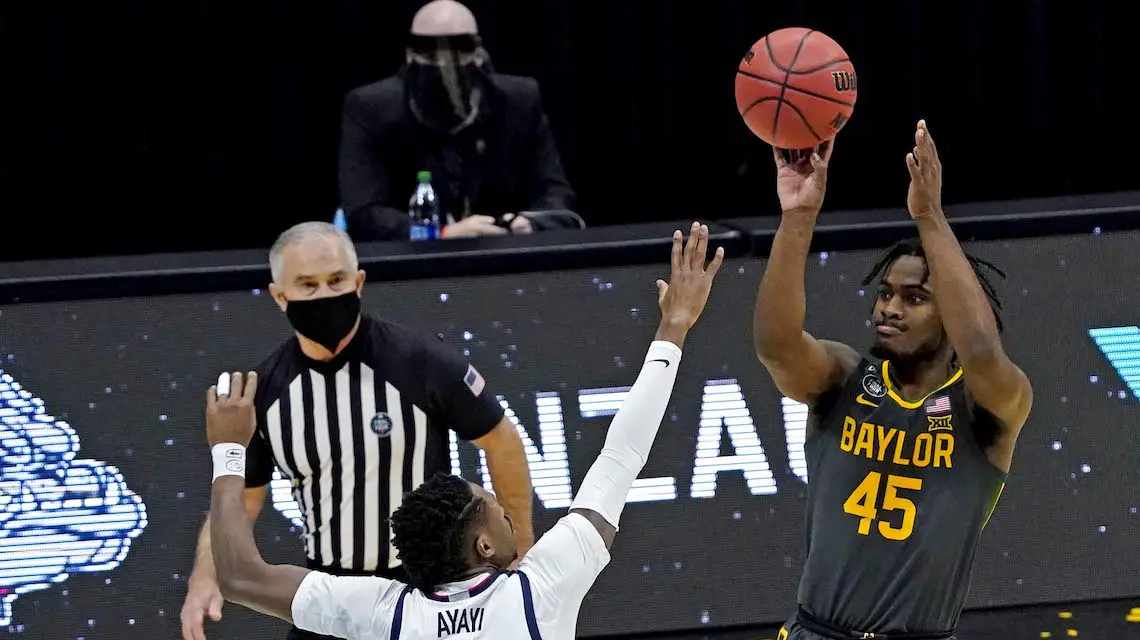
Robert Deutsch/USA TODAY Sports
With March Madness in the rearview mirror and months before college basketball is back, the NCAA is considering some significant rule changes for men’s basketball.
On Friday, May 7, the NCAA’s rules committee reviewed 13 possible adjustments to the current regulations for the sport. Of those, five rule changes are being recommended.
It’s not a done deal just yet, though. Those modifications still need to go before another committee.
If approved at an upcoming meeting of the Playing Rules Oversight Panel (PROP), the changes would go into effect for the 2021-2022 college basketball season.
So, what’s potentially on the table for the next season of men’s college basketball?
1. Live stats allowed on the bench
Tech-savvy teams will love this proposed rule, which allows live statistics to be streamed on the bench.
Certain devices will be permitted on the bench, allowing head coaches, assistant coaches, and other staffers to see live stats stream in during games.
Individual conferences would also be permitted to decide on the official regulations for viewing live and pre-loaded videos on tech devices on the bench.
This is an experimental rule that’s been previously tested in National Invitation Tournament (NIT) games. If it’s passed by this year’s committee, it won’t apply to non-conference games or the NCAA tournament.
2. Technical fouls for flopping
One of the proposed rule changes that’s gaining a lot of buzz in the basketball world involves flopping. If the change is approved, a flop would result in a technical foul.
A flop is essentially “faking” a foul. Typically, the player exaggerates contact and falls backward, trying to simulate a foul. In most instances, it’s defensive players who flop while trying to draw a charging foul.
Currently, NCAA officials only dole a warning for a flop.
This change would bring the NCAA closer in line with the NBA, which already delivers a technical foul (and sometimes even fines) for flopping.
3. Bumping up to six fouls for disqualification
The game of basketball is incredibly fast and physical in nature. In the 2020-2021 season, officials called an average of 17.24 fouls per team in NCAA Division I games.
As a result, the current limit of five personal fouls can sometimes seem a little too restrictive.
That’s why one of the proposed rule changes involves increasing the limit of personal fouls in a single game to six.
This is another rule change that appears to be modeled after the NBA, which currently has a six-foul limit.
It’s also something that’s been tested in NCAA ball in the past. From 1989 to 1992, the Big East Conference used a six-foul rule.
But this change is a little more complicated than simply increasing the limit to six fouls per player.
Players could rack up no more than three fouls per half. Four personal fouls in the first half or second half would result in disqualification from the rest of the game.
The rule (if approved) would be instituted on a trial basis at the NIT for two seasons in a row before deciding whether to apply it for all NCAA men’s basketball games.
4. Streamline timeouts for televised games
Sick of the stop-and-start nature of televised NCAA games?
New timeout rules currently under review could change that.
Right now, men’s games have media timeouts after the 16, 12, eight, and four-minute mark of each half. These breaks occur based on when an official whistles for play to stop.
This change would allow team timeouts to double as media timeouts, as long as a media timeout for that period of the game hasn’t already been used.
That means fewer stoppages in the game and more continuous action on the court, which is almost certain to please fans, players, and coaches alike.
5. Shot clock showing tenths of a second
The committee is recommending that shot clocks be permitted to display tenths of a second as time runs down.
This rule is the simplest of them all. It’s also one that would be totally optional for schools to implement.
Many fans might be surprised to realize this rule isn’t already in place. Since the 2011-2012 season, the NBA has required shot clocks to show tenths of a second beginning at 5 seconds remaining.
Which proposed NCAA rule changes didn’t make the cut?
The NCAA men’s basketball rules committee decided not to pursue several other potential changes to to the official rules, including:
- Expanding the free throw lane from 12 feet to 16 feet
- Getting rid of the 10-second backcourt rule
- Switching possession of the ball to the defensive team after a held ball instead of using a jump ball
- Introducing “quasi-quarters,” which would reset team fouls at the 10-minute mark of each half and begin double bonus on the fifth foul within each quasi-quarter
- Giving offensive teams the option to choose inbound throw-ins over free throws in the final two minutes of games and in overtime
- Permitting the use of instant replay on shot clock violations that occur in the final two minutes or overtime
New rules should be announced this June after a review by the Playing Rules Oversight Panel (PROP). Keep in mind that these rules will apply only to NCAA men’s basketball, not women’s basketball.